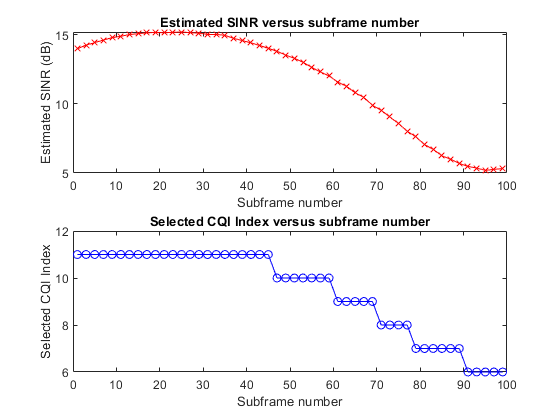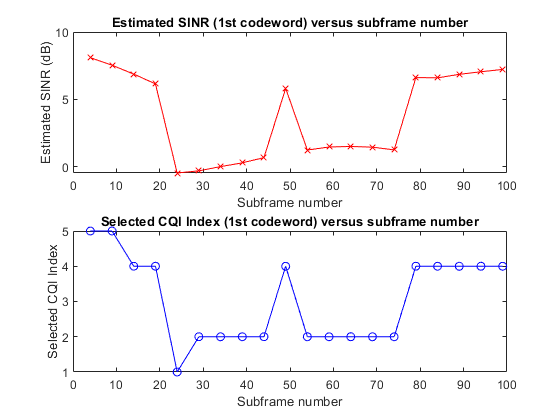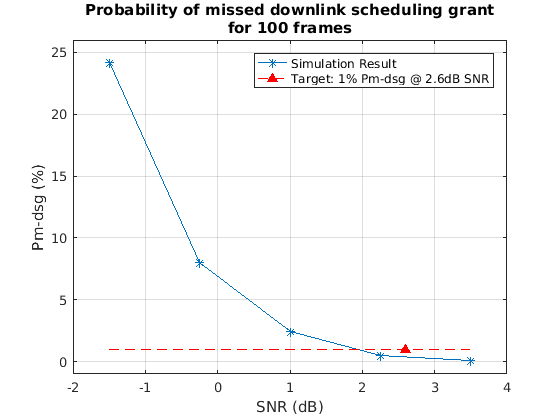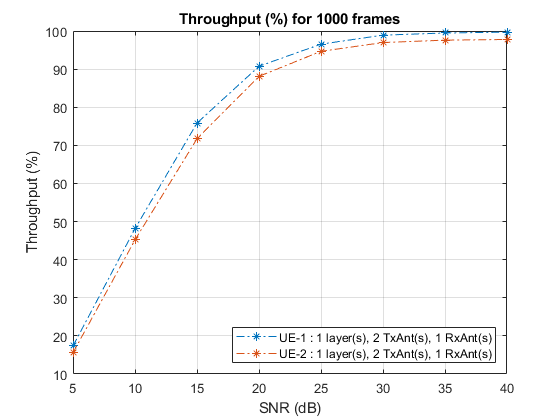RMC and Conformance
RMC, FRC, and E-TM configuration and waveform generation; link-level BER and
conformance test
Functions and apps to define reference measurement channel (RMC), fixed reference channel (FRC), and E-UTRA test model (E-TM) configurations and perform waveform generation. Also includes an app for PDSCH conformance testing. Examples demonstrate generation of end-to-end communication link simulation and performance assessment of these links.
Apps
| LTE Waveform Generator | Create, impair, visualize, and export LTE waveforms |
| LTE Throughput Analyzer | Generate throughput curves for physical downlink shared channel (PDSCH) conformance test analysis |
Functions
Topics
Test Models and BER
- Generate a Test Model
The LTE specifications define conformance test models for transmitter tests. - PDSCH Bit Error Rate Curve Generation
This example shows how the LTE Toolbox™ can be used to create Physical Downlink Shared Channel (PDSCH) Bit Error Rate (BER) curves under Additive White Gaussian Noise (AWGN) in a simple Graphical User Interface (GUI).
Link-Level Simulation
- Release 10 PUSCH Multiple Codeword Transmit and Receive Modeling
This example demonstrates the multicodeword transmission and reception in the uplink. - PDSCH Port 5 UE-Specific Beamforming
This example demonstrates release 8 port 5 UE-specific beamforming with the LTE Toolbox™. - Release 10 PDSCH Enhanced UE-Specific Beamforming
This example demonstrates the Release 10 UE-specific beamforming capability of the LTE Toolbox™ and shows how an appropriate choice of beamforming matrix leads to better performance. - Release 12 Downlink Carrier Aggregation Waveform Generation, Demodulation and Analysis
This example shows how multiple downlink carriers can be generated, aggregated and further demodulated using the LTE Toolbox™. - Time Difference of Arrival Positioning Using PRS
This example shows how to use the Time Difference Of Arrival (TDOA) positioning approach in conjunction with the Release 9 Positioning Reference Signal (PRS) to calculate the position of a User Equipment (UE) within a network of eNodeBs using the LTE Toolbox™.
PUSCH Performance Requirements
- PUSCH Throughput Conformance Test
This example demonstrates how to measure the Physical Uplink Shared Channel (PUSCH) throughput performance using the LTE Toolbox™ under conformance test conditions as defined in TS36.104. - Release 10 PUSCH Multiple Codeword Throughput Conformance Test
This example measures the throughput performance of the Physical Uplink Shared Channel (PUSCH) with closed-loop spatial multiplexing using the LTE Toolbox™ under a 2-codeword Release 10 UL-MIMO scenario, based on conformance test conditions as defined in Table 8.2.1.1-7 of TS 36.104. - PUSCH HARQ-ACK Detection Conformance Test
This example shows how to measure the false detection probability and missed detection probability of Hybrid Automatic Repeat Request ACK (HARQ-ACK) multiplexed on the Physical Uplink Shared Channel (PUSCH) using the LTE Toolbox™ under conformance test conditions as defined in TS36.104, Section 8.2.4.1.
PUCCH Performance Requirements
- PUCCH1a ACK Missed Detection Probability Conformance Test
This example measures the Acknowledgment (ACK) missed detection probability using the LTE Toolbox™ under the single user Physical Uplink Control Channel (PUCCH1a) conformance test conditions as defined in TS 36.104 Section 8.3.2.1. - PUCCH2 CQI BLER Conformance Test
This example shows how to measure the channel quality indicator (CQI) block error rate (BLER), which indicates the probability of incorrectly decoding CQI information sent using physical uplink control channel (PUCCH) format 2. - PUCCH1a Multi User ACK Missed Detection Probability Conformance Test
This example shows how to use the LTE Toolbox™ to measure the probability of Acknowledgment (ACK) missed detection for multiuser Physical Uplink Control Channel (PUCCH) 1a. - PUCCH3 ACK Missed Detection Probability Conformance Test
This example measures the ACK missed detection probability using the LTE Toolbox™ under the single user Physical Uplink Control Channel (PUCCH3) conformance test conditions as defined in TS 36.104 Section 8.3.6.1. - NB-IoT PRACH Detection and False Alarm Conformance Test
This example implements the narrowband physical random access channel (NPRACH) missed detection and false alarm conformance tests for frame structure type 1, as defined in TS 36.141.
PRACH Performance Requirements
- PRACH False Alarm Probability Conformance Test
This example shows how the LTE Toolbox™ can be used to model a TS36.104 Physical Random Access Channel (PRACH) false alarm probability conformance test. - PRACH Detection Conformance Test
This example shows how the LTE Toolbox™ can be used to model a TS36.104 "PRACH Detection Requirements" conformance test.
Downlink Performance Requirements
- Analyze Throughput for PDSCH Demodulation Performance Test
This standalone example shows how to use the LTE Throughput Analyzer App. - PDSCH Throughput Conformance Test for Single Antenna (TM1), Transmit Diversity (TM2), Open Loop (TM3) and Closed Loop (TM4/6) Spatial Multiplexing
This example demonstrates how to measure the Physical Downlink Shared Channel (PDSCH) throughput performance using LTE Toolbox™ for the following transmission modes (TM):







